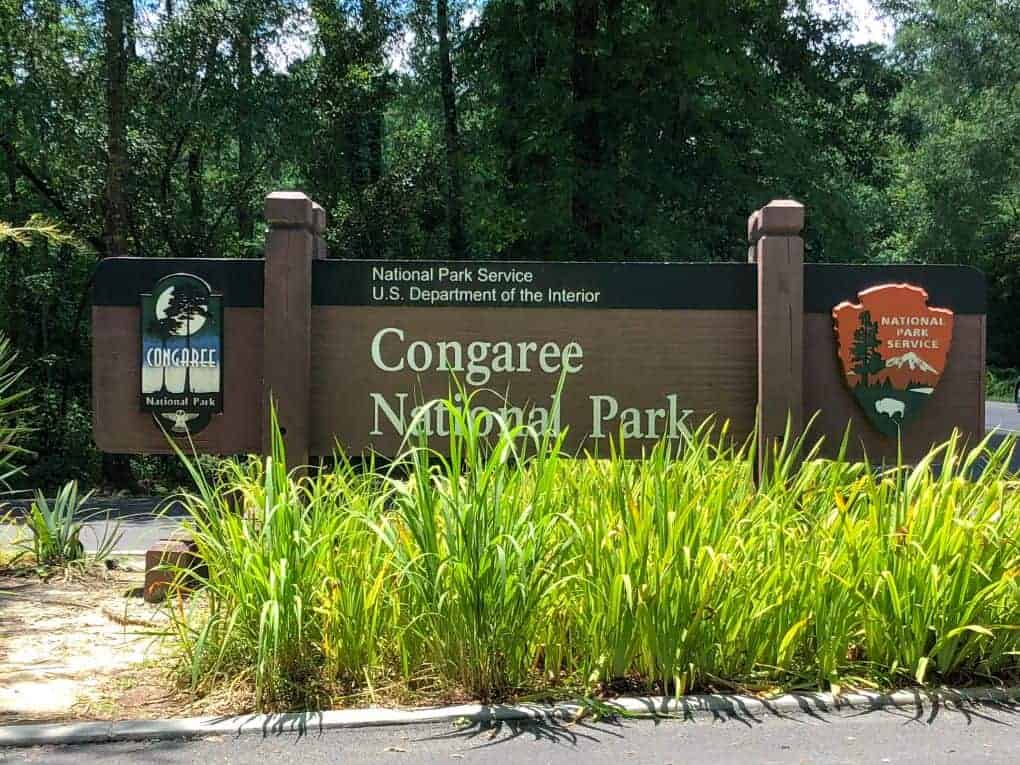Congaree National Park encompasses 27,000 acres of pristine forest, home to champions – the largest remaining old-growth bottomland forest in North America. The closest metropolitan area is Columbia, South Carolina, a mere 20-miles northwest of Congaree, yet the park feels miles away from civilization. The isolation and solitude make this place a perfect escape. Some will only see a muddy mosquito-infested swamp, but there is much more going on here if you look. This is an amazing biodiverse ecosystem. It has one of the highest natural forest canopies in the world, over 100 feet in most areas.
This post may contain affiliate links, meaning if you purchase something through one of these links, we may earn a small commission at no extra cost to you! Read the full disclosure policy here.
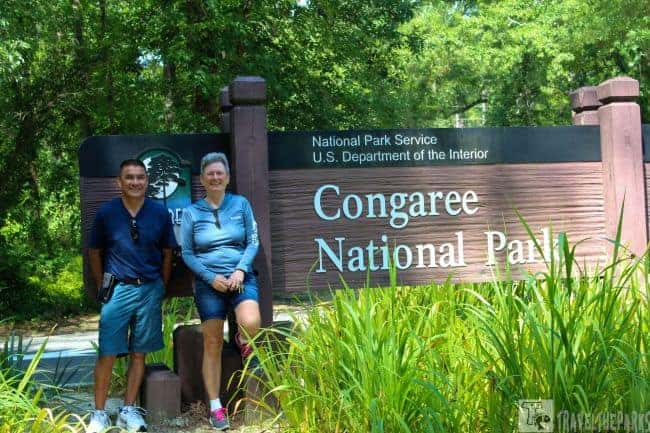
Table of Contents
History of Congaree National Park
The immense floodplain formed by the meandering Congaree and Wateree Rivers is the major reason this park exists. The annual floods carry nutrients and sediments that nourish and rejuvenate this unique ecosystem, giving rise to the goliath hardwoods. Lumber barons tried to claim it, wanting the timber harvested for profit. By the late 1800s, loggers decimated the forests of South Carolina. They relentlessly took the biggest trees they could locate, clearing vast sections of bottomland. Fortunately for the trees of the Congaree River, but the sheer logistics of removing the timber made it inaccessible for centuries. The Cypress trees were too heavy to float, and the insects left workers with malaria.
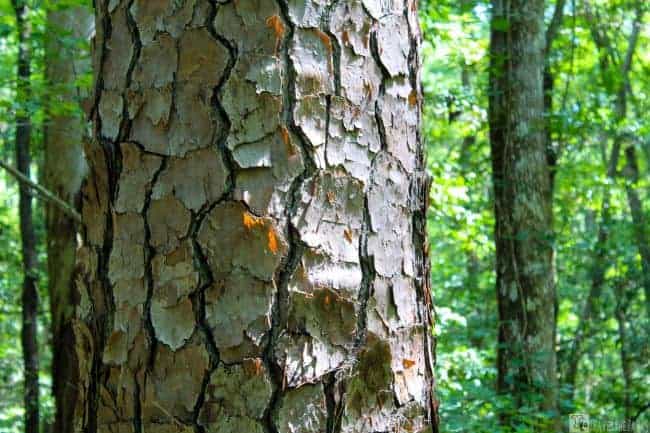
Francis Beidler owned the Santee River Cypress Lumber Company, one of the largest in South Carolina. When lumber prices tanked in the early 1900s, he decided to set aside some bottomland hardwood as a timber reserve. The land remained intact until the 1960s, when logging operations resumed. Conservationist Harry Hampton started a grassroots campaign, forming the Congaree Swamp National Preserve Association. Finally, in 1976, President Gerald Ford signed legislation establishing Congaree Swamp National Monument. Finally, in 2003, Congaree was designated a National Park.
Congaree – Home of Champion Trees
The American Forest organization, which is the oldest national non-profit conservation organization in the U.S. manages the National Big Tree Program. Congaree is home to 25 National and State Champion trees, the highest concentration anywhere in the US. So What is a Champion tree you may ask? Well, basically a champion tree is defined as the largest known tree of a particular species. The champion Loblolly Pine here towers over a record-breaking height of 167 feet. The park’s largest Bald Cypress has a base circumference of 27 feet, 131 ft tall, surrounded with “knees.”

Why does Congaree produce champion trees? Well, the answer is simple: the long, warm growing season and constant flooding provide what the trees need to survive. Therefore, the park is nicknamed the “Redwoods of the East.”
Best Time to Visit Congaree – Home of Champions
I guess it really depends on what you want to see in the park. In December through mid-April, floods typically occur, submerging nearly 80 to 90 percent of the park. If you come in the late fall, winter and early spring, you will miss the mosquitoes. The fall showcases the spectacular colors of the leaves in all their splendor.
Late April to mid-May and from late October to early November are prime birdwatching seasons because of the increase in migratory birds that overwinter in the park.

Plan your visit to Congaree National Park
Congaree National Park is open 24 hours a day, year-round. The entrance to Congaree National Park is free. They require no entry fee. Congaree National Park is off the beaten path located just outside Hopkins, SC. After leaving Interstate 95, we traveled back roads, passing through many small-towns and landscapes. It made getting to the park a real treat. We did this as part of our East coast road trip.
We visited this humid subtropical park in the summer. Be sure to wear long sleeves, long pants, and pack insect repellant. It gets hot in the summer, and you’ll dehydrate before you know it. Bring water and a snack if you’re going for more than a short hike.
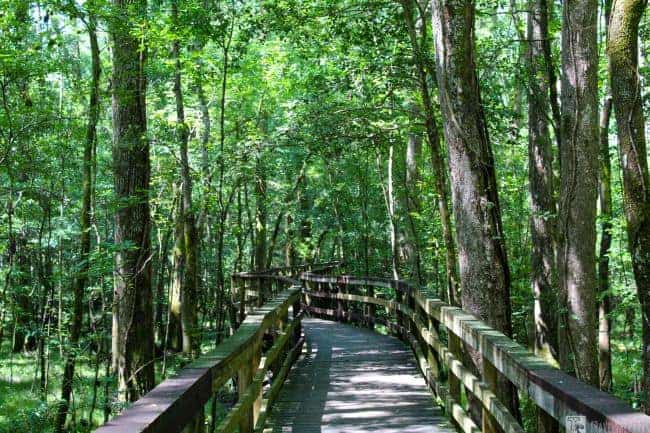
Things to Do and Explore in Congaree National Park
The most notable park for viewing synchronous fireflies is probably the Great Smoky Mountains. However, a little know secret is that Congaree has its own event. You can witness the synchronous fireflies without the fanfare in the Congaree from mid-May to mid-June. Call 803.776.4396 or visit the park website at the park website for the exact dates of the firefly display. No reservation, just show up and enjoy the show!

Congaree National Park is a birder’s paradise with 170 documented species, a botanist’s dream with over 80 tree species, and a river rat’s playground with 60 reptiles and amphibian and 49 fish species surveyed.

Today, undoubtedly the most well-known aspect of the park is the champion Loblolly pine, Bald Cypress and Tupelo trees. Here, just a tiny elevation difference changes the terrain and the tree species. It is very dramatic moving from the Loblolly pine forests to the Cypress wetlands. The park feels almost timeless, a fairytale scene. Taking a hike on one of the 25-miles of trails will get you familiar with the park.
Easily the most popular trail in the park is the 2.4-mile Boardwalk Loop Trail. It is a flat, easy walk, accessible to wheelchairs and convenient for families with small children. Did I mention that this is a dog-friendly National Park that allows dogs on the trail? The trail begins right behind the visitor’s center. The trail begins on the elevated bluff of pinewoods descending to the bottomland hardwoods on the floodplain. The raised wooden boardwalk is a giant loop that traverses through the bottomland.
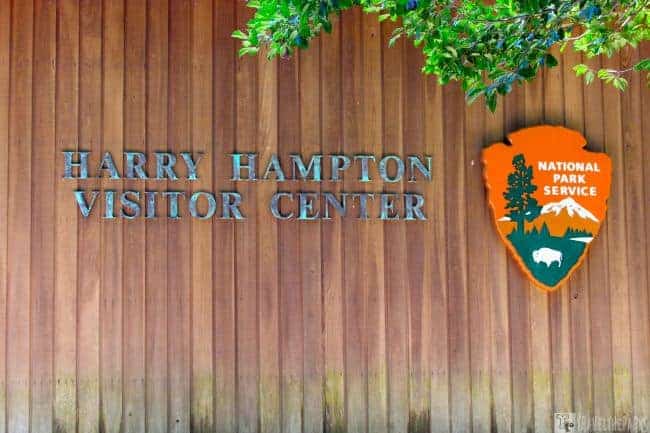
Harry Hampton Visitor Center
The park’s elegant visitor center is named in honor of Harry Hampton. The Visitor Center is open 7 days a week, from 9 AM to 5 PM. Trail maps, brochures, water, and restrooms are available at the Visitor Center breezeway 24 hours a day. There are water bottle refill stations available 24 hours a day, located beside the restrooms at the center. A short video summarizing the park is excellent and worth watching. They lead Ranger and volunteer guided programs on Saturdays year-round. The park provides two ranger-led hikes, the Nature Discovery Walk, or the Big Tree Hike. The Big Tree Hike covers about 5-miles led by park founder John Cely is 3-hours very informative walk through the primeval forest.
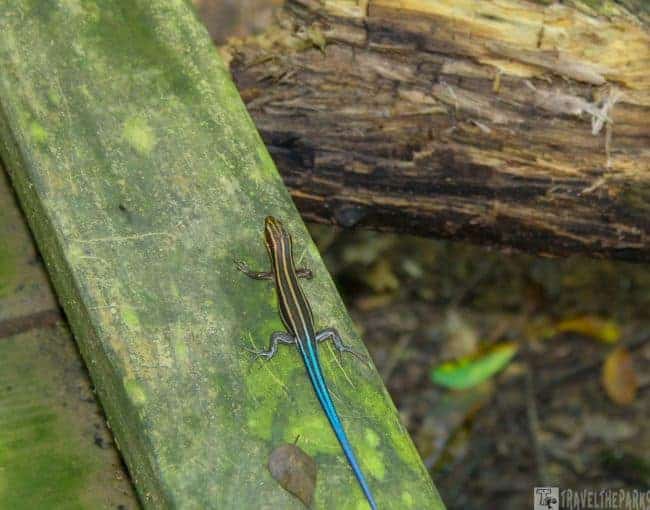
Boardwalk Loop Trail
The Mosquito Meter at the visitor center today was a 3. We expected a swarm, so we doused ourselves in repellant before heading down the trail. Be sure to get a self-guided tour brochure for the Boardwalk loop, as it has numbers that coincide with the brochure along the path with fascinating explanations of what you are seeing. This was our favorite trail in the park. This is an excellent way to learn and appreciate what the park offers. If you stop at one of the benches, you can listen to the many songbirds. We saw Brown-headed Nuthatch, Brown Creeper, and a Black-throated Blue Warbler. In the underbrush, we spotted a deer browsing.
It really is hard not to marvel at the sheer size of these trees. The light barely filters through to the forest floor in most places along the trails. It was a challenge just seeing the tree tops almost 7 stories above us.
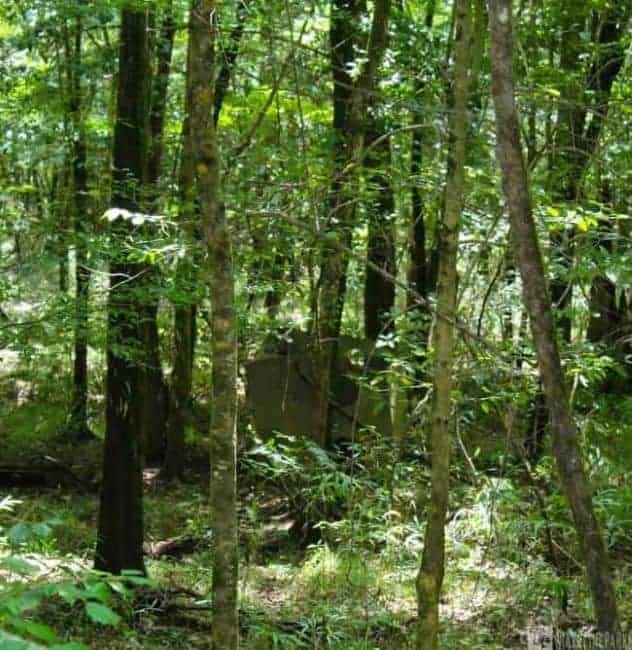
At each stop, we read the brochure, discovering the cultural history and significance. I love looking for the unique wildlife that inhabits a park. I followed a five-lined skink, found colorful fungi and unusual millipedes, finding these treasures to take it in and enjoy their gifts. We loved the lookout at Weston Lake. It was enjoyable watching the turtles; it was obvious someone had fed them. I wish I had a fishing rod just to cast a bit, alas, next time. At stop #15, the remnants of a prohibition-era moonshine still are visible through the underbrush. During the prohibition years, bootleggers took refuge to make the illegal Elixir hidden by the difficult terrain. Miraculously, we did not have issues with mosquitoes, not a one.
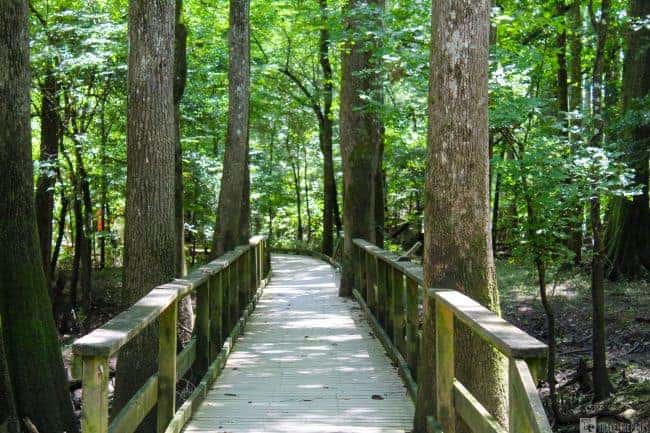
Paddle a Trail in Congaree National Park
We highly recommend canoeing or kayaking down Cedar Creek for a somewhat different experience-you definitely need insect repellant on this trek. Congaree is a BYOK (bring your own Kayak/Canoe) park, with a few launches just outside the park. The 20-mile Cedar Creek Canoe Trail begins at Cedar Creek Landing, going all the way to the Congaree River, finishing at Bates Bridge Boat Landing at Hwy 601. You can always take a guided trip using one of the park vendors. Canoeing is really a great way to see this park.

On Friday, Saturday, and Sunday, there is a ranger-led canoe trip. They limit space to 12 people.. For reservations call (803) 776-4396 or online at Recreation.gov this adventure is free! The park provides canoes, life vests, and paddles. The tour takes you through the lush backcountry, inhabited by bobcats, deer, and playful river otters.
If you are really adventurous, try the Congaree River Blue Trail. It is the first water trail designated a National Recreation Trail in South Carolina by the Department of the Interior. It is a 50-mile recreational paddling trail on the Congaree River, extending from the City of Columbia to the Congaree National Park.

Know Before You Go to Congaree National Park
- Water levels can fluctuate as much as 10 feet on the creek. Know beforehand what the water level is. The USGS maintains two gauges in the park: the Cedar Creek Gauge and the Congaree River Gauge.
- If the water level is high, markers may not be visible-bring a map.
- Watch for downed trees. You will need to portage over.
- Beware the Wildlife that inhabits the park such as spiders, snakes, and stinging insects, especially in summer months. Poison Ivy is also prevalent.
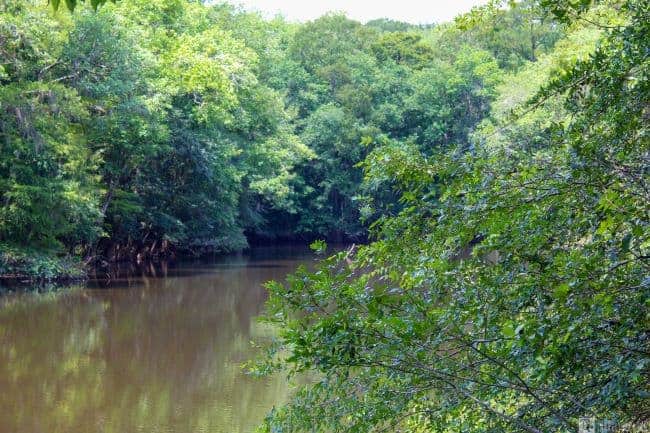
Other Hiking Trails – Congaree
Be sure to talk to the ranger at the Visitors Center and ask about the condition of the trails, as they are often wet and muddy or completely underwater at certain times of the year.
Weston Loop Trail – Easy
Weston Lake Loop Trail is 4.4 miles out & back to Cedar Creek. Keep in mind that sections can be extremely wet and soft. Be cautious. Look for snakes. They’re out there, and I almost stepped on one. So keep your eyes on the trail as you’re hiking. Having a good pair of waterproof hiking boots is a must on this trail. The trail runs along the north shore of Weston Lake until we saw juvenile skinks, an amazing diversity of spiders, and the hooting of the barred owl, although we could not see him.
Bluff Trail – Easy
Takes you 1.7 miles through a young forest of loblolly and longleaf pines. I found evidence of prescribed burns along this trail.

Sims Trail-Easy
Follows an old gravel road 3.2 miles and crosses the site of a hunt club where conservationist Harry Hampton was once a member.
Kingsnake Trail – Easy
This is a 12-mile a favorite trail for birders because of the diverse vegetation and proximity to Cedar Creek. When sloughs are full of water, beautiful views are possible around every bend. There are trees down…there are wet areas…there are bugs…it is a swamp. Mosquitos can be ruthless, so keep that in mind!

Oakridge Trail – Moderate
A 7-mile hike through old-growth forest, along a subtle ridge, and keep your eye out for wildlife like deer and turkey. There are several old-growth trees on this hike, and many bridges to cross. We had to climb over and hike around dozens of downed trees. Luckily there are trail markers consistently placed on the trees so we did not get lost. The quiet beauty and tranquility of the backcountry is worth the hike.
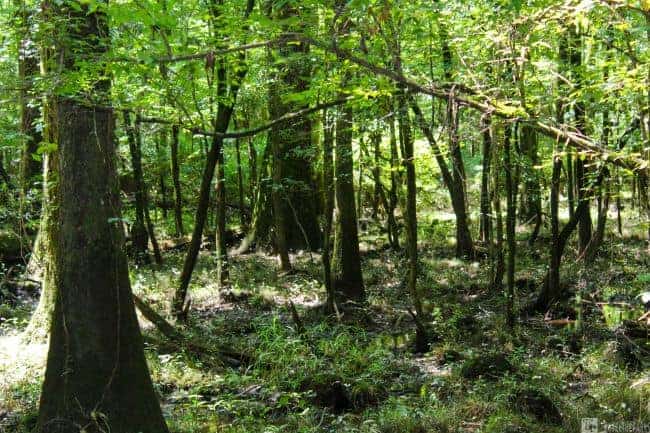
Camping in Congaree National Park
There are two designated campgrounds in Congaree National Park, Longleaf and Bluff campgrounds, both are tent only. You must make reservations for the campgrounds through Recreation.gov or by calling 1-877-444-6777. The Longleaf camp area has porta potties, fire rings, and picnic tables. No potable water in the campground must use the visitor center water refill station. Those staying at the Bluff campgrounds must walk the 1-mile to set up camp. NO water or restroom. They require permits for backcountry camping.

Final Thoughts on Congaree – Home of Champion Trees
Congaree National Park may be one of the least visited national parks, but it holds some of the tallest and most majestic trees in the eastern United States—earning its title as the Home of Champion Trees. From towering loblolly pines to record-setting sweetgums and tupelos, this old-growth forest offers a rare chance to walk among living giants in one of the country’s unique ecosystems.
Whether you’re hiking the Boardwalk Loop Trail, paddling through the floodplain forest, or simply standing still beneath the canopy, Congaree rewards those who slow down and look up. It’s not just a place of beauty—it’s a national treasure for tree lovers, nature seekers, and anyone in search of the wild.
Don’t miss the chance to explore this quiet wonder. The champion trees of Congaree are waiting.
Did you know Congaree was a National Park? Have you visited the park? What did you enjoy most about your visit? Share a comment below. We would love to know your experience!!

